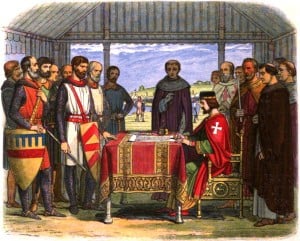On Saturday, The Wall Street Journal published an article by Daniel Harmann celebrating the 800th anniversary of the Magna Carta. In recognition of this event, this blog has sporadically published translations of portions of the famous charter. See It’s Magna Carta Friday! and Magna Carta Friday – King John Guarantees The Freedom Of The English Church. The Wall Street Journal article is accompanied by a one-half page, above-the-fold reproduction of James Doyle's woodblock illustration of the event in the famous meadow between Staines and Windsor. Since Doyle's artwork is in the public domain, I've reproduced it below:
Doyle shows the King with pen in hand signing the charter. Lest there be any doubt a to what is being depicted, The Wall Street Journal captions the picture with "KING JOHN, pressured by English barons, reluctantly signs Magna Carta . . .". This is incorrect. King John did not actually sign the charter by applying pen to parchment. It was authenticated by affixing the royal seal.
Is sealing tantamount to signing? Both the California Civil Code and the Corporations Code allow a mark, but only when the person cannot write:
[S]ignature or subscription includes mark, when the person cannot write, his name being written near it, by a person who writes his own name as a witness; provided, that when a signature is by mark it must in order that the same may be acknowledged or may serve as the signature to any sworn statement be witnessed by two persons who must subscribe their own names as witnesses thereto.
Cal. Civ. Code § 14. A very similar but not identical provision is found in Section 17 of the Corporations Code. However, King John was certainly no rex illiteratus. He could read and write, having abided with, and presumably been tutored by, Henry II's justiciar, Ranulph de Glanville. A.L. Poole, From Domesday Book to Magna Carta 1087 to 1216 in Oxford History of England, 243 (1951).
The Commercial Code, however, admits a broader view of what constitutes a signing:
“Signed” includes using any symbol executed or adopted with present intention to adopt or accept a writing.
Cal. Com. Code § 1201(a)(37). The official comment elaborates as follows:
Authentication may be printed, stamped or written; it may be by initials or by thumbprint. . . . The question always is whether the symbol was executed or adopted by the party with present intention to authenticate the writing.
But what if King John had in fact signed, but not sealed, the Magna Carta? The California Corporations Code would attach no significance to the missing seal. Section 207(a) provides that the "failure to affix a seal does not affect the validity of any instrument."
In the article itself, Mr. Hannan, a British member of the European Parliament, avoids claiming that King John signed the Magna Carta: "The meadow where the abominable King John put his royal seal to the parchment lies in my electoral district . . .". However, it seems that Mr. Hannan may be in error here as well. The charter ends with the following lines:
Juratum est autem tam ex parte nostra quam ex parte baronum, quod hec omnia supradicta bona fide et sine malo ingenio observabuntur. Testibus supradictis et multis aliis. Data per manum nostram in prato quod vocatur Ronimed. inter Windlesoram et Stanes, quinto decimo die junii, anno regni nostri decimo septimo.
It having been sworn under oath on our part as well as on the part of the barons that everything written above will be observed in good faith and without bad intent. Those named above and many others being witnesses. Given by my hand in a meadow which is called Runnymede between Windsor and Staines on the fifteenth day of June in the seventeenth year of our reign.
According to the document itself, the critical event in the meadow was the King's swearing of an oath, not signing or sealing. The copies of the charter were produced and sealed later. Only one of the original copies retains its seal of beeswax.
Note to readers: In this post, I've followed the American custom of referring to the charter as "the Magna Carta". The English tend to omit the article "the", preferring simply "Magna Carta" as in Mr. Hannan's article. See Magna Carta Friday: A Definitive Article About A Definite Article.



.png?width=100&height=100&name=corporate_law_blogs%20(1).png)